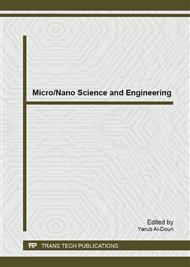[1]
G. Scott & J. Woltman, Liquid-crystal materials find a new order in biomedical applications, J. Nature Materials. 6 (2007) 929 – 938.
DOI: 10.1038/nmat2010
Google Scholar
[2]
N. L. Abbott. Yan-Yeung Luk, Sean F. Campbell, Non-toxic thermotropic liquid crystals for use with mammalian cells. 31(2004) 611–621.
DOI: 10.1080/02678290410001666020
Google Scholar
[3]
C. F. Soon, M. Youseffi, N. Blagden, R. Berends, S. B. Lobo, F. A. Javid, and M. Denyer, Characterization and biocompatibility study of nematic and cholesteryl liquid crystal, Proceeding of World Congress on Engineering UK. 2 (2009)1-4.
DOI: 10.1007/978-3-642-03900-3_4
Google Scholar
[4]
C. F. Soon, M. Youseffi, P. Twigg, N. Blagden, M.C.T. Denyer, Finite element quantification of compressive forces induced by keratinocyte on a liquid crystal substrate. Analysis and Design of Biological, Materials and Structures, Ochsner, Andreas (Ed), Springer–Verlag, Berlin Heidelberg. (2012).
DOI: 10.1007/978-3-642-22131-6_7
Google Scholar
[5]
C. F. Soon, M. Youseffi, T. Gough, N. Blagden, M.C.T. Denyer, Rheological characterization of the time-dependent cholesteric based lyotropic liquid crystals, J. Materials Science and Engineering C. 31(2011) 1389-1397.
DOI: 10.1016/j.msec.2011.05.006
Google Scholar
[6]
C. F. Soon, M. Youseffi, N. Blagden, M.C. T Denyer, Development of liquid crystal based a cell traction force transducer system, J. Biosensors and Bioelectronics. 3 (2013) 14-20.
DOI: 10.1016/j.bios.2012.06.032
Google Scholar
[7]
B. O. Palsson and S. N. Bhatia, Tissue Engineering, Upper Saddle River, NJ, US, Pearson Prentice Hall. p.254, (2004).
Google Scholar
[8]
T. Hurbett, B. Ratner, J. Schakenraad, and F. Schoen, Biomaterials science: An introduction to materials in medicine. New York: Academic Press. (1996) 133–164.
Google Scholar
[9]
G. Lamour, A. Hamraoui, A. Buvailo, Y. Xing, S. Keuleyan, V. Prakash, A. Eftekhari-Bafrooei, and E. Borguet, Contact angle measurements using a simplified experimental setup. 87 (2010) 1403–1407.
DOI: 10.1021/ed100468u
Google Scholar
[10]
Fox, H. W. and Zisman, W. A. J. Colloid Sciences, p.514, 5(1950).
Google Scholar
[11]
S. Naemura, Polar and nonpolar contributions to liquid-crystal orientations on substrates, J. Applied Physics. 51 (1980) 6149.
DOI: 10.1063/1.327602
Google Scholar
[12]
P. van der Meulen , H. Zhang , A. M. Jonkman , and M. Glasbeek, Subpicosecond Solvation Relaxation of 4-(Dicyanomethylene)-2-methyl-6-(p-(dimethylamino)styryl)-4H-pyran in Polar Liquids, J. Physical Chemistry. 13 (1996) 5367–5373.
DOI: 10.1021/jp952949r
Google Scholar
[13]
Soo-Jin Park, Min-Kang Seo, Interface Sciences and Composite. UK: Academic Press, p.167, (2011).
Google Scholar
[14]
T. Stoebe, P. Mach, & C. C. Huang, Surface tension of free-standing liquid crystal films, 49 (1994) R3587–R3590.
DOI: 10.1103/physreve.49.r3587
Google Scholar
[15]
H. S. C. H. Uring, C. Thieme, and R. Stannarius, Surface Tensions of Smectic Liquid Crystals, 28(1998) 241–252.
DOI: 10.1080/02678290010006270
Google Scholar
[16]
Hyde. S, Identification of lyotropic liquid crystalline mesophase. In: Holmberg, K. (ed. ) Handbook of Applied Surface and Colloid Chemistry. Wiley, New York , (2001).
Google Scholar


